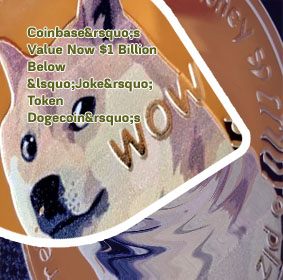
Coinbase dogecoin
As the popularity of Dogecoin continues to rise, many investors are turning to popular platforms like Coinbase to buy and trade this cryptocurrency. If you're looking to learn more about investing in Dogecoin through Coinbase, here are 4 articles that can help you navigate this process:
As the popularity of Dogecoin continues to rise, many investors are turning to popular platforms like Coinbase to buy and trade this cryptocurrency. If you're looking to learn more about investing in Dogecoin through Coinbase, here are 4 articles that can help you navigate this process:
The Beginner's Guide to Buying Dogecoin on Coinbase

Dogecoin has been gaining popularity in recent years, thanks to its meme-inspired origins and the support of influential figures like Elon Musk. As a result, many people are interested in buying Dogecoin as a way to invest in this digital currency. One popular platform for buying Dogecoin is Coinbase, which is known for its user-friendly interface and strong security measures.
To buy Dogecoin on Coinbase, beginners can follow a few simple steps. First, they need to create an account on Coinbase and verify their identity. Then, they can add a payment method, such as a credit card or bank account, to fund their account. Once the account is funded, users can search for Dogecoin on the Coinbase platform and place an order to buy the desired amount of Dogecoin.
It is important to note that Coinbase charges fees for buying and selling Dogecoin. These fees can vary based on the payment method used and the size of the transaction. Additionally, the price of Dogecoin can be volatile, so it is important to be aware of the risks involved in investing in this digital currency.
Overall, the beginner's guide to buying Dogecoin on Coinbase provides valuable information for those who are interested in getting started with investing in Dogecoin. By following
Tips for Trading Dogecoin on Coinbase Like a Pro
In recent years, Dogecoin has gained significant popularity as a cryptocurrency investment. As one of the top digital currencies available on Coinbase, it offers a great opportunity for traders to profit. However, trading Dogecoin successfully requires a certain level of skill and knowledge. To help traders navigate this market effectively, here are some key tips to keep in mind.
First and foremost, it is essential to stay informed about the latest trends and news related to Dogecoin. By keeping abreast of developments in the cryptocurrency world, traders can make more informed decisions about when to buy or sell their Dogecoin holdings. Additionally, setting clear goals and sticking to a trading strategy can help minimize risks and maximize profits.
Another important tip is to diversify your portfolio to reduce the impact of market fluctuations. By investing in a variety of cryptocurrencies, traders can spread out their risk and potentially increase their overall returns. Additionally, using technical analysis tools and indicators can help traders identify potential entry and exit points for their trades.
Overall, trading Dogecoin on Coinbase can be a lucrative endeavor for those who approach it with the right mindset and strategy. By staying informed, diversifying their portfolio, and using technical analysis tools, traders can increase their chances of success in the cryptocurrency market.
Understanding the Fees Associated with Buying Dogecoin on Coinbase
Investing in cryptocurrencies like Dogecoin can be an exciting yet complex venture, especially when it comes to understanding the fees associated with buying and trading on popular platforms like Coinbase. As a beginner or seasoned investor, it is crucial to have a clear understanding of the fees involved to make informed decisions and maximize your investment potential.
When buying Dogecoin on Coinbase, you may encounter various fees that can impact your overall investment. Coinbase charges a spread of about 0.50% for cryptocurrency purchases and sales. Additionally, there is a Coinbase Fee, which is either a flat fee or a percentage of the transaction amount, depending on the payment method used. For example, using a bank account incurs a lower fee compared to using a debit card.
Furthermore, Coinbase also charges a fee for transferring your Dogecoin to an external wallet or another exchange. This network fee varies depending on the current network congestion and can fluctuate over time. It is essential to consider these fees when planning your investment strategy to avoid any surprises and ensure that you are getting the most out of your investment.
In conclusion, understanding the fees associated with buying Dogecoin on Coinbase is crucial for all investors looking to enter the cryptocurrency market. By being aware of these fees and factoring them into your investment decisions
Strategies for Safely Storing Your Dogecoin Purchased on Coinbase
As cryptocurrency continues to gain popularity, it is crucial for investors to understand the importance of securely storing their digital assets. When it comes to Dogecoin, a popular cryptocurrency available for purchase on Coinbase, there are several strategies that can help ensure the safety of your investment.
-
Hardware Wallets: Consider transferring your Dogecoin to a hardware wallet, such as Ledger or Trezor, for added security. These physical devices store your private keys offline, making it nearly impossible for hackers to access your funds.
-
Paper Wallets: Another option for storing Dogecoin is a paper wallet. This involves printing out your private key and public address on a piece of paper and storing it in a secure location, such as a safe deposit box.
-
Multi-Signature Wallets: Multi-signature wallets require multiple signatures to authorize a transaction, adding an extra layer of security. This can be a great option for those looking to store a large amount of Dogecoin.
-
Cold Storage: Keeping your Dogecoin offline in cold storage can protect it from online threats. Consider storing your cryptocurrency on a USB drive or external hard drive that is not connected to the internet.
-
Strong Passwords and Two-Factor Authentication: When using online wallets or exchanges